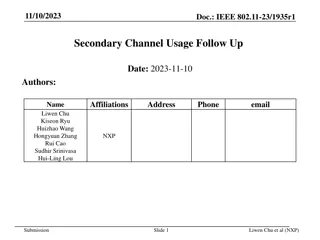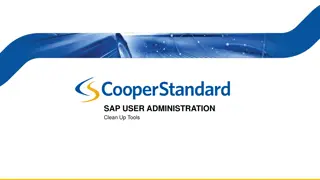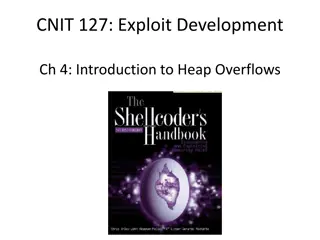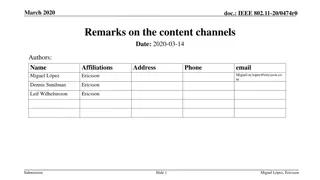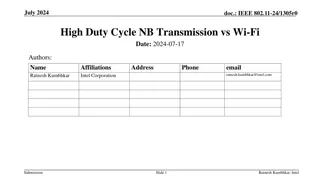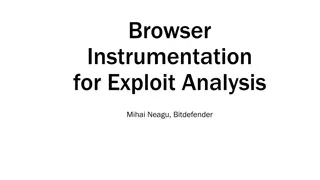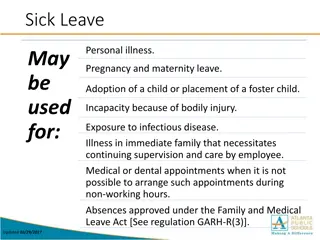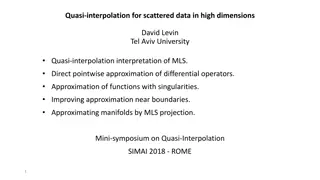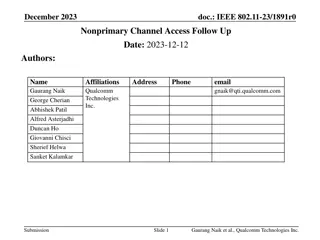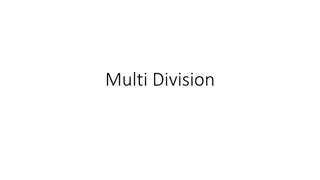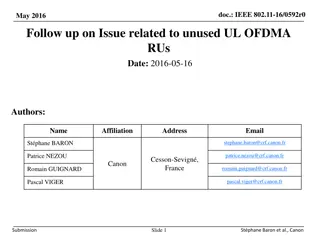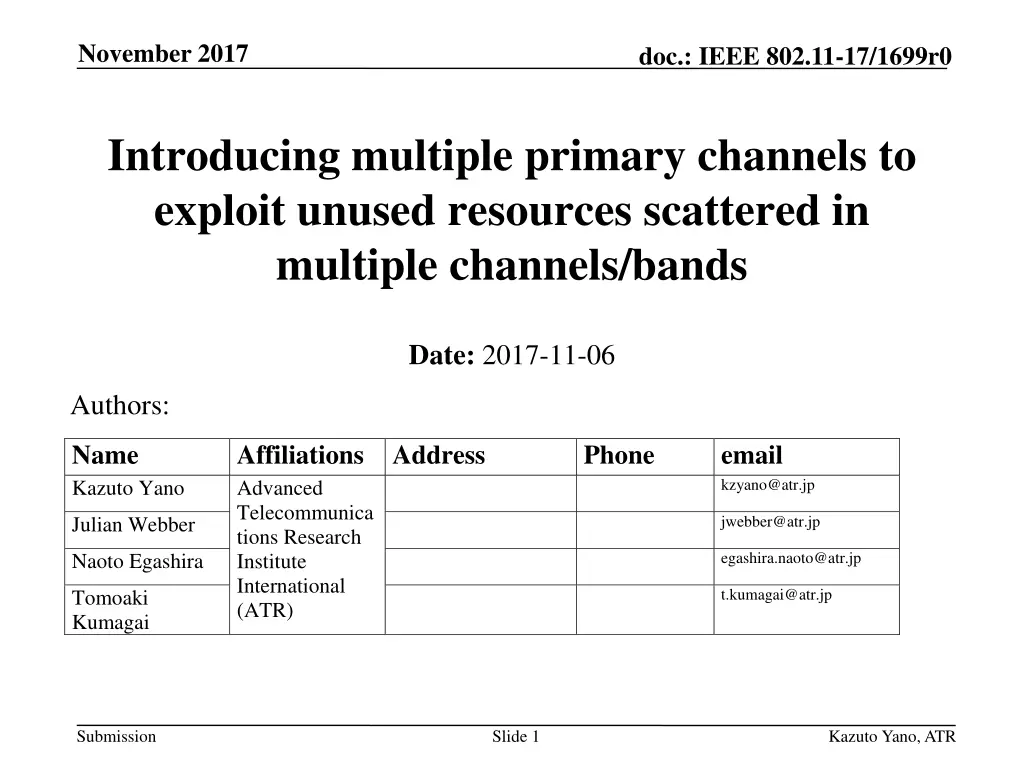
Exploiting Unused Resources in Wireless LAN for Enhanced System Throughput
"Learn how to improve wireless LAN system throughput by utilizing scattered unused resources across multiple channels. This presentation introduces the concept of multiple primary channels to optimize transmission chances, based on IEEE 802.11 standards. Discover insights on channel usage measurements, back-off procedures, and evaluation results for enhancing Quality of Service (QoS)."
Download Presentation

Please find below an Image/Link to download the presentation.
The content on the website is provided AS IS for your information and personal use only. It may not be sold, licensed, or shared on other websites without obtaining consent from the author. If you encounter any issues during the download, it is possible that the publisher has removed the file from their server.
You are allowed to download the files provided on this website for personal or commercial use, subject to the condition that they are used lawfully. All files are the property of their respective owners.
The content on the website is provided AS IS for your information and personal use only. It may not be sold, licensed, or shared on other websites without obtaining consent from the author.
E N D
Presentation Transcript
November 2017 doc.: IEEE 802.11-17/1699r0 Introducing multiple primary channels to exploit unused resources scattered in multiple channels/bands Date: 2017-11-06 Authors: Name Kazuto Yano Affiliations Address Advanced Telecommunica tions Research Institute International (ATR) Phone email kzyano@atr.jp jwebber@atr.jp Julian Webber egashira.naoto@atr.jp Naoto Egashira t.kumagai@atr.jp Tomoaki Kumagai Submission Slide 1 Kazuto Yano, ATR
November 2017 doc.: IEEE 802.11-17/1699r0 Background (1) The amount of wireless LAN traffic is still increasing due to expansion of applications and off-loading of cellular traffic. To meet the increasing demand, enhancement of system throughput of the wireless LAN is still necessary. WLAN traffic becomes 4 times in 5 years. Growth of IP traffic forecasted by Cisco [1]. Submission Slide 2 Kazuto Yano, ATR
November 2017 doc.: IEEE 802.11-17/1699r0 Background (2) 500 We conducted measurements of channel usage at a main-line railway station in Japan [2,3]. Example 500 ms snapshot of spectrogram shows there are many short unused resources with durations of typically 10- 70 ms. If we can utilize these scattered unused resources, we can obtain more transmission chances and can improve QoS. 400 300 200 100 0 Ch. 1 (Left) 2.4 and (Right) 5 GHz Spectrogram 6 108 112 116 Submission Slide 3 Kazuto Yano, ATR
November 2017 doc.: IEEE 802.11-17/1699r0 Background (3) In current IEEE 802.11 wireless LAN, a BSS sets one primary channel (PCH) on which each STA invokes the back-off procedure to obtain a transmission opportunity (TXOP) [4]. However, if channel load of the PCH is relatively high, some STAs would hardly obtain enough TXOPs to achieve required QoS even though unused resources exist on other channels. Frame from other STA Frequency My transmitted frame PCH Secondary channel Time These unused resources are not available. Submission Slide 4 Kazuto Yano, ATR
November 2017 doc.: IEEE 802.11-17/1699r0 Contents of this presentation We have presented some basic ideas to exploit such scattered unused resources to obtain more transmission chances. [2,3,5]. This presentation proposes detailed methods to exploit such unused resources. This presentation also shows some evaluation results of area throughput when our proposed methods are employed. Submission Slide 5 Kazuto Yano, ATR
November 2017 Multiple PCHs to obtain transmission chances on multiple channels/bands doc.: IEEE 802.11-17/1699r0 To obtain a transmission chance even when the primary channel is busy, we propose to set multiple PCHs. These PCHs can be set in different frequency bands. A STA independently invokes the back-off process using EDCAF (or DCF) on each PCH. Frequency My transmitted frame Waiting on back-off Frame from other STA Band A PCH 1 Secondary channel for PCH 1 PCH 2 Secondary channel for PCH 2 Band B PCH 3 Secondary channel for PCH 3 Time Submission Slide 6 Kazuto Yano, ATR
November 2017 doc.: IEEE 802.11-17/1699r0 How to access multiple PCHs There are three ways to transmit a frame on PCHs. a. Simultaneous transmission on multiple PCHs : Transmit a channel- bonded frame across multiple PCHs on which transmission chances are obtained (similar to 80+80 MHz non-contiguous transmission in 802.11ac). b. Concurrent (asynchronous) transmission on multiple PCHs : Transmit a frame immediately on a PCH if a transmission chance is obtained on the PCH. If inter-channel interference is negligible (frequency separation between PCHs is large), multiple frames can be concurrently transmitted on different PCHs. c. Non-concurrent transmission : Transmit a frame immediately on a PCH if a transmission chance is obtained on the PCH. If inter- channel interference is not negligible (frequency separation between PCHs is small), only one frame can be transmitted at a time. Submission Slide 7 Kazuto Yano, ATR
November 2017 Simultaneous transmission on multiple PCHs doc.: IEEE 802.11-17/1699r0 If transmission chances are obtained on multiple PCHs, a channel-bonded frame is transmitted on the PCHs. If OFDM(A) is used, this method is available even when PCH separation is small due to synchronous transmission. If the PCHs used for simultaneous transmission are far apart in the frequency domain, high frequency-diversity gain is expected. Frequency Back-off slot Waiting to finish back- off on other PCH Back-off finish Band A PCH 1 Secondary channel for PCH 1 PCH 2 Secondary channel for PCH 2 Band B PCH 3 Secondary channel for PCH 3 Time Submission Slide 8 Kazuto Yano, ATR
November 2017 Concurrent transmission on multiple PCHs doc.: IEEE 802.11-17/1699r0 If a transmission chance is obtained on one of the multiple PCHs, a frame is immediately transmitted on that PCH. Concurrent transmission is available only when PCH separation is large so that inter-channel interference is negligible. A STA may wait frame transmission until another PCH finishes back-off to perform simultaneous transmission. Frequency Band A PCH 1 Secondary channel for PCH 1 ~~ PCH 2 Secondary channel for PCH 2 Band B PCH 3 Secondary channel for PCH 3 Time Submission Slide 9 Kazuto Yano, ATR
November 2017 doc.: IEEE 802.11-17/1699r0 Non-concurrent transmission Even when transmission chances are obtained on multiple PCHs, a STA can transmit a frame only on one PCH at a time if PCH separation is small so that inter-channel interference doesn t occur. However, transmission chances will be increased by multiple PCHs if unused resources are scattered. Frequency Busy due to inter-channel interference Band A PCH 1 Secondary channel for PCH 1 PCH 2 Secondary channel for PCH 2 Time Submission Slide 10 Kazuto Yano, ATR
November 2017 Impact of MIMO gain on frame length doc.: IEEE 802.11-17/1699r0 The duration of payload in DATA frame is almost inversely proportional to the MIMO gain. If the payload size of DATA frame is large, the time necessary to transmit DATA is also inversely proportional to the MIMO gain. If the payload size is small, MIMO gain has less affect on the time necessary to transmit DATA because the duration of payload size becomes comparable to the durations of preamble and SIGs. Long DATA case Preamble + SIG Payload (DATA) Payload (ACK/BA) MIMO gain becomes a half Time Time Short DATA case MIMO gain becomes a half Time Time Submission Slide 11 Kazuto Yano, ATR
November 2017 Effect of introducing multiple PCHs doc.: IEEE 802.11-17/1699r0 Simultaneous transmission increases the transmission rate by spending RF chains to increase the signal bandwidth. It will have a gain when the length of data frame is long. Concurrent transmission increases the number of transmission chances by spending RF chains (reducing MIMO gain). It will have a large gain when the length of data frame is short. Single PCH Time Simultaneous transmission Time Single PCH Time Concurrent transmission Time Submission Slide 12 Kazuto Yano, ATR
November 2017 doc.: IEEE 802.11-17/1699r0 Queue sharing among PCHs To effectively exploit unused resources scattered in the time and frequency domains, EDCA queue are shared by multiple PCHs. MSDU is de-queued to the PCH on which a transmission chance is obtained. Submission Slide 13 Kazuto Yano, ATR
November 2017 Hardware structure for multiple PCHs Since current STA have multiple BB/RF units for MIMO transmission, we consider that some of BB/RF units are tuned to additional PCH(s) to save the increase of hardware complexity. doc.: IEEE 802.11-17/1699r0 Even when a STA has many antennas, the achievable transmission rate of MIMO would not be high if fading correlation is high (as in LOS environment). In such a condition, using multiple PCHs will be beneficial even though the number of antennas per PCH is small. 2-channel parallel contention transceiver (N/2-antenna, 2 PCHs) MIMO transceiver (N-antenna) Submission Slide 14 Kazuto Yano, ATR
November 2017 Mode switching of single/multiple PCHs doc.: IEEE 802.11-17/1699r0 The gain brought by multiple PCHs will depend on channel environment (whether fading correlation is high or low) and channel status (whether under congestion or not) of each band. We consider to switch operating mode between legacy (single-PCH) mode and multi-PCH mode according to environment and channel status. An AP will announce new mode to associated STAs by a broadcast packet (such as beacon) when the channel condition changes. Announcement to switch operating mode Operating on single-PCH mode (e.g. 4 x 4 MIMO) Operating on multi-PCH mode (e.g. 2 x 2 MIMO x 2 PCHs) Single-PCH Multi-PCH Time Fading correlation is low Other channel is crowded Fading correlation becomes high Other channel gets less crowded Submission Slide 15 Kazuto Yano, ATR
November 2017 doc.: IEEE 802.11-17/1699r0 Performance evaluation To evaluate the gain brought by multiple PCHs, we conducted computer simulations assuming 2.4 GHz and 5 GHz bands. For simplicity, we conduct simulation based on 802.11n (2.4 GHz band) and 802.11ac (5 GHz band). Following cases are compared (all STAs have 4 RF chains): All BSSs are legacy WLAN (one PCH in either band, 4x4 MIMO). Some of BSSs (proposed BSS) employ 2 PCHs (one PCH in each band, with concurrent transmission (CT) between 2 bands, 2x2 MIMO). Proposed BSSs employ 4 PCHs (two PCHs in each band, with CT between 2 bands and non-concurrent transmission in each band, SISO). Proposed BSSs employ 4 PCHs (two PCHs in each band, with CT between 2 bands and non-concurrent but in-band simultaneous transmission (ST) in each band, SISO). Submission Slide 16 Kazuto Yano, ATR
November 2017 doc.: IEEE 802.11-17/1699r0 Evaluation configuration (1/2) Area size : 80 m x 80 m (20 m x 20 m segment, 4 x 4 segments) Number of BSSs : 15 (Proposed BSSs : 0 or 2) Number of STAs per BSS : 10 Position of AP/STA : uniformly random in a segment Submission Slide 17 Kazuto Yano, ATR
November 2017 doc.: IEEE 802.11-17/1699r0 Evaluation configuration (2/2) Tx power per antenna : 14 dBm (AP), 9 dBm (STA) Max. Tx bandwidth per PCH : 40 MHz (2.4 GHz), 80 MHz (5 GHz) Traffic : All STAs have downlink traffic. Full buffer traffic : 2 links (assigned to proposed BSSs if they exist, otherwise assigned to legacy BSSs) HTTP traffic (data size is 20 times larger in average as TGax Evaluation Methodology [6]) Channel model : ITU-R IMT-Adv MCM UMi LOS MIMO gain is simply obtained based on the results in [7]. PCH selection : Select channel with min. busy rate (every 10 s) Frame aggregation : 16 MSDUs are aggregated, or not employed Submission Slide 18 Kazuto Yano, ATR
November 2017 Simulation result (w/ frame aggregation) doc.: IEEE 802.11-17/1699r0 Following two cases are assumed: 15 legacy BSSs (3 BSS in 2.4 GHz band, 12 BSSs in 5 GHz band) 2 proposed and 13 legacy BSSs (2 and 11 BSSs in 2.4 GHz and 5 GHz bands) The proposed approach improves area throughput by 58 %. Average area throughput Utilization rate in PHY layer Submission Slide 19 Kazuto Yano, ATR
November 2017 Simulation result (w/o frame aggregation) doc.: IEEE 802.11-17/1699r0 Following two cases are assumed: 15 legacy BSSs (3 BSS in 2.4 GHz band, 12 BSSs in 5 GHz band) 2 proposed and 13 legacy BSSs (2 and 11 BSSs in 2.4 GHz and 5 GHz bands) The proposed approach improves area throughput by 68 %. Average area throughput Utilization rate in PHY layer Submission Slide 20 Kazuto Yano, ATR
November 2017 doc.: IEEE 802.11-17/1699r0 Summary To exploit unused resources scattered in time and frequency domains and obtain transmission chances on such resources, we have proposed to set multiple PCHs and three ways to use obtained transmission chances. Simultaneous (channel-bonded) transmission on multiple PCHs Concurrent (asynchronous) transmission on multiple PCHs Non-concurrent transmission We have confirmed through computer simulation that the proposed methods can utilize more radio resources and achieve higher average area throughput than current single- PCH transmission without increase of RF chains. Submission Slide 21 Kazuto Yano, ATR
November 2017 doc.: IEEE 802.11-17/1699r0 Straw Poll #1 Do you think that introducing multiple primary channels is an effective approach to enhance achievable QoS? Yes: No: Need more information: Abstain: Submission Slide 22 Kazuto Yano, ATR
November 2017 doc.: IEEE 802.11-17/1699r0 References [1] Cisco, Cisco Visual Networking Index: Global Mobile Data Traffic Forecast Update, 2016 2021, Cisco White Paper C11-738429-00, February 2017. [2] doc. IEEE 802.11-17/0410r0. [3] doc. IEEE 802.11-17/0767r0. [4] IEEE 802.11-2016. [5] doc. IEEE 802.11-17/0129r3. [6] doc. IEEE 802.11-14/0571r12. [7] IEICE Trans. Commun., vol. E92-B, no. 9, pp. 2773- 2788, Sept. 2009. Submission Slide 23 Kazuto Yano, ATR
November 2017 doc.: IEEE 802.11-17/1699r0 Appendix Submission Slide 24 Kazuto Yano, ATR
November 2017 Calculation of MIMO gain and Tx rate doc.: IEEE 802.11-17/1699r0 We define MIMO gain as the ratio of capacity between MIMO transmission and SISO transmission. (Therefore, the MIMO gain of SISO transmission is 1.) The CCDF of MIMO gain of 4 x 4 transmission is obtained from the result shown in [7]. The MIMO gain of 2 x 2 transmission is obtained by linear interpolation. The transmission rate of MIMO transmission is calculated by multiplying the transmission rate of SISO with the MIMO gain. MIMO gain MIMO gain of 4 x 4 trans. Given as a random value based on the result in [7] 1 1 2 4 Number of antennas Submission Slide 25 Kazuto Yano, ATR


